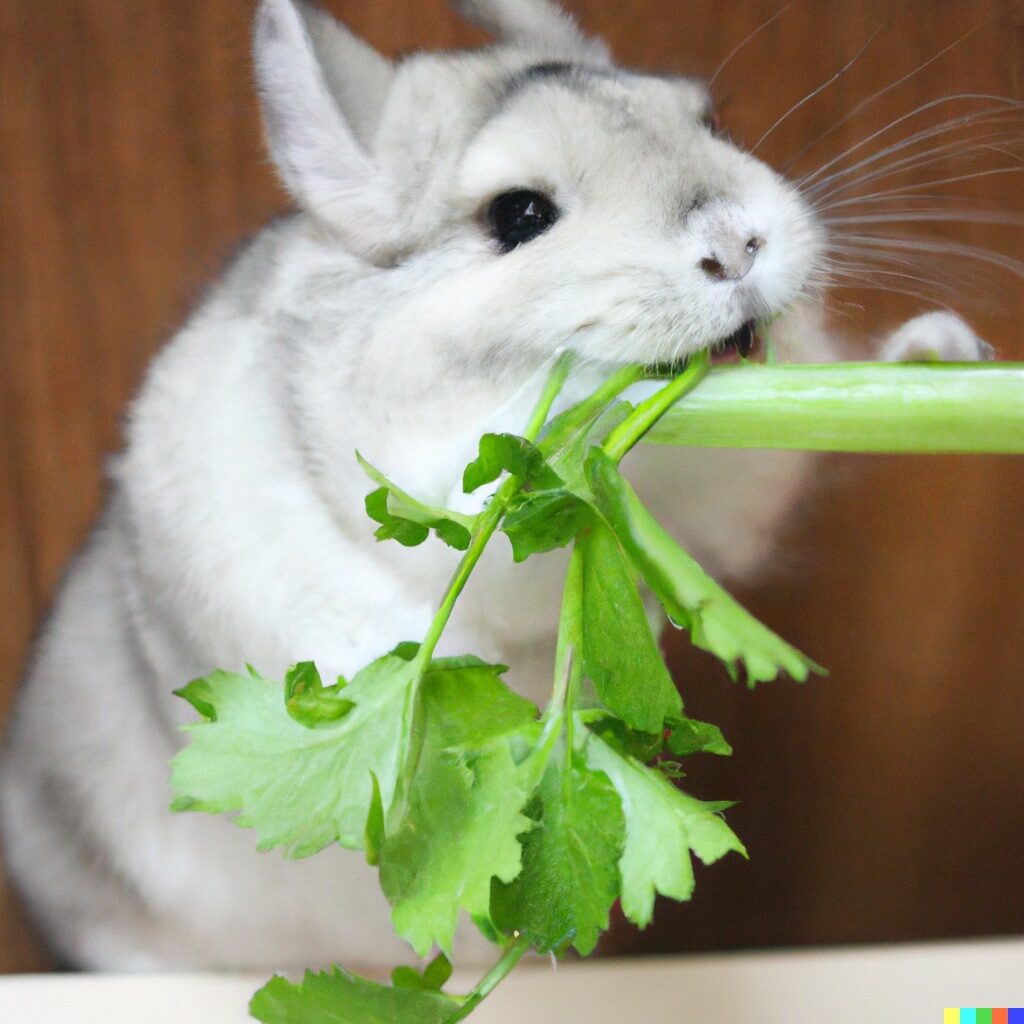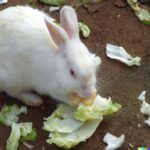No, chinchillas should not eat celery. Celery is a high–water content vegetable, which can cause dehydration and other health problems in chinchillas. In addition, celery contains a compound called oxalic acid, which can be toxic in high quantities and can cause kidney damage. Chinchillas should not be given any food that is high in oxalic acid, including celery.
Are you a chinchilla owner curious about what foods your furry friend can and cannot eat? Well, one vegetable that commonly comes up in conversations is celery. So, can chinchillas eat celery? To answer this question and learn more about feeding your chinchilla this veggie, keep reading!
Risks Associated with Feeding Chinchillas Celery
Many potential chinchilla owners are unaware of the risks associated with feeding celery to their beloved pet. Celery is one popular choice for treats, but it can be dangerous for a chinchilla if not handled correctly.
First and foremost, celery contains high levels of oxalic acid which can cause severe problems in many animals including chinchillas. Oxalic acid binds to calcium in the digestive tract and prevents absorption into the body. This can lead to an accumulation of toxins that may result in kidney stones or even death if left untreated over time. Furthermore, too much celery could cause bloating and gas due to its high fiber content so it should only be given as a treat on occasion rather than a daily snack.
In addition to these health concerns, there are also potential choking hazards associated with giving your chinchilla celery sticks. The strings found inside each stick must be removed before providing them as snacks – otherwise they may become entangled within your pet’s mouth or throat leading to difficulty breathing and other serious issues such as aspiration pneumonia or suffocation.
It’s important that you exercise caution when considering whether or not celery is suitable for your specific pet since no two animals will have the same reaction when consuming this particular food item. Every animal has different dietary requirements based on various factors like age, size, activity level and overall health condition; so it’s best to consult with an experienced veterinarian before introducing any new foods into their diet – especially ones containing potentially harmful components like oxalic acid.2
Finally, proper storage techniques must always be employed when storing celery at home – either cooked or raw – since spoilage from bacteria growth could put your lovely companion at risk of food poisoning (especially if consumed uncooked). Always make sure that all pieces are completely dry before placing them in sealed containers away from direct sunlight; preferably refrigerated until ready for use.3
All things considered, feeding your chinchilla some occasional pieces of fresh organic celery under supervision isn’t necessarily bad practice – just remember moderation is key! By taking necessary precautions outlined above you can ensure both safety & enjoyment during mealtime while avoiding any unnecessary risks along the way!
References:
- 1) Merck Veterinary Manual : Oxalates https://www.merckvetmanual.com/toxicology/plants/oxalates
- 2) PetMD : Feeding Your Chinchilla – What You Should Know https://www.petmd.com/chinchilla/nutrition/evr_ct_feeding_your_chinchlla
- 3) Small Animal Channel : Storing Vegetables & Fruits For Pets https://smallanimalchannel.com/careguides/foodstorageforpets.
Is There a Safe Way to Give Chinchillas Celery?
Giving chinchillas celery can be a great way to provide additional variety in their diets, but it’s important to do it safely. Celery is high in water content and low in calories, so if your chinchilla has too much of it there’s a good chance they won’t get enough nutrients from the rest of their food. It also contains oxalic acid which can accumulate and cause health problems over time.
Preparing Celery for Chinchillas
When preparing celery for your chinchilla you should:
- Wash the stalks carefully to remove any dirt or pesticides.
- Cut off all the leaves as these contain more oxalic acid than the stalks.
- Chop up the stalk into small pieces so that your chinchilla doesn’t choke on them.
It’s also important not to give your chinchilla too much celery at once – no more than one or two stalks a week is generally recommended. If you want to add more variety you could try giving them other vegetables such as carrots, broccoli, zucchini, cucumber or squash.
Introducing Celery Safely
You should always introduce new foods slowly and gradually when feeding them to your pet. Start by offering just a few pieces of chopped celery once or twice a week and observe how they react – if they seem happy with this amount then you can increase it slightly each time until you reach around one or two stalks per week.
If at any point during this process your pet seems uninterested in trying something new then don’t force them – go back to what worked before and try again another day. Doing things this way will help ensure that both you and your pet have an enjoyable experience when introducing new foods!
How Much Celery Can a Chinchilla Eat?
Chinchillas are incredibly popular pets, but it can be difficult to know exactly how much food they need. Celery is a widely available vegetable and many people want to know if their chinchilla can eat it safely. The answer is that yes, celery can make up part of a chinchilla’s diet – but only in small amounts!
Why Is Celery Suitable for Chinchillas?
Celery contains plenty of essential vitamins and minerals that are beneficial for your pet’s health, including folate, Vitamin K, magnesium and potassium. It also provides dietary fiber which helps with digestion and keeps the intestines healthy. As long as the celery is washed thoroughly beforehand, there should be no problem with introducing it into your pet’s diet.
How Much Can A Chinchilla Eat?
When feeding your chinchilla celery or any other fresh vegetable or fruit treat, moderation is key! These treats should not make up more than 10% of their daily intake – this means one-tenth of 1 cup (or about 2 tablespoons) per day maximum. Always monitor them while they’re eating these treats too; some animals may find them irresistible and overeat on occasion! To ensure a balanced diet overall you’ll want to feed your pet hay first (at least 80%), followed by pellets (10 – 15%) then fresh vegetables/fruits as mentioned earlier (no more than 10%).
If you’re looking for an occasional snack for your chinchilla that is both safe yet nutritious then look no further than celery! Just remember though: like all foods given to animals in captivity, moderation is key! With careful monitoring from you as the owner – plus adhering strictly to the recommended portion sizes – giving your furry friend some crunchy celery stalks every now and again shouldn’t present any problems at all.
Tips for Preparing and Serving Celery to Your Pet Chinchilla
When it comes to preparing and serving celery to your pet chinchilla, there are several things that you should consider. First of all, it’s important to make sure the celery is fresh. Celery that has been sitting around for too long can be a breeding ground for bacteria and parasites, which could put your chinchilla at risk of getting sick. To ensure its freshness, purchase organic celery from a reputable source whenever possible.
Washing the Celery
Once you have obtained the celery, it is important to wash it thoroughly before feeding it to your pet chinchilla. Use cold water and a gentle brush or cloth to remove any dirt or debris from the stalks and leaves of the plant. Be sure not to use any soap as this can cause irritation if ingested by your pet. After washing, pat dry with paper towels or let air-dry completely before serving.
Serving Celery Safely
Before offering the celery as food for your pet chinchilla, there are some steps you should take:
- Cut off any browned edges on both sides of each stalk.
- Chop into small pieces approximately 1/2 inch in size so they don’t pose a choking hazard.
- Discard any outer leaves that have visible signs of decay.
When giving these pieces of chopped celery out as treats, do so sparingly – no more than once per week – as too much may lead to digestive upset and diarrhea in your chinchilla due excessive fiber content in their diet.. Additionally, avoid adding other foods such as fruits or vegetables when providing them with this treat.
Additional Considerations
It is also important not feed wilted or discolored celery stalks; these are likely old and contain less nutritional value than freshly purchased ones would provide . Furthermore , always monitor how much your pet consumes over time . If you notice an increase in water intake , gas , bloating , weight loss , vomiting etc., then stop offering this treat immediately until consulting with a veterinarian .
Common Questions About Feeding Your Chinchilla This Vegetable
What Vegetable Can I Feed My Chinchilla?
Chinchillas are herbivores, so their diets should consist of hay and a variety of vegetables. Popular options include carrots, green beans, bell peppers, spinach, squash and cucumber. You can also offer your chinchilla treats such as apples or bananas in moderation – just make sure to remove any uneaten pieces before they spoil. In addition to fresh fruits and veggies, you can feed your pet a specialized pellet diet that is specific to chinchillas. It’s important to note that some vegetables should be avoided at all costs – these include garlic, onions or anything with sugar or salt added.
How Much Should I Feed My Chinchilla?
When it comes to feeding time for your chinchilla you should provide them with small portions twice per day- once in the morning and once in the evening. When offering fresh vegetables make sure not to give them too much; one tablespoon per day is usually sufficient. If your chinchilla refuses food then reduce the portion size accordingly until they start eating again.
Are There Any Benefits To This Vegetable For My Pet?
Not only do vegetables provide essential vitamins and minerals for your pet but they also help keep their teeth healthy which is vital for good health overall! Carrots are particularly beneficial as they contain vitamin A which helps strengthen vision while other veggies like spinach contain iron which supports red blood cell production. All of these nutrients combined help build strong bones while providing energy throughout the day – making this vegetable an excellent choice when it comes to keeping your pet happy and healthy!










